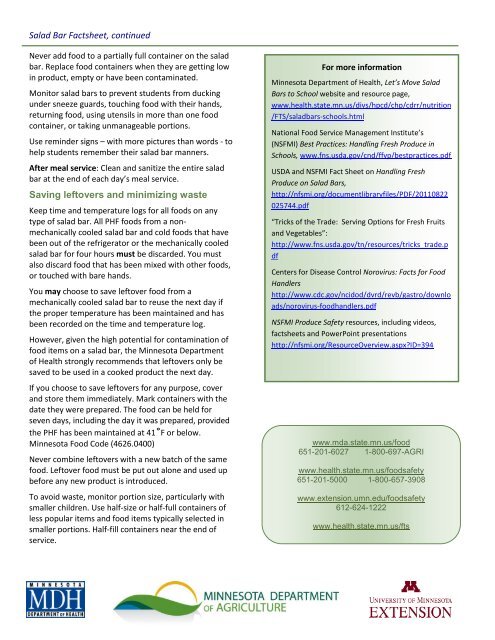A Field Guide To Salad Bars In Schools - Minnesota Department of ...
A Field Guide To Salad Bars In Schools - Minnesota Department of ...
A Field Guide To Salad Bars In Schools - Minnesota Department of ...
Create successful ePaper yourself
Turn your PDF publications into a flip-book with our unique Google optimized e-Paper software.
<strong>Salad</strong> Bar Factsheet, continued<br />
Never add food to a partially full container on the salad<br />
bar. Replace food containers when they are getting low<br />
in product, empty or have been contaminated.<br />
Monitor salad bars to prevent students from ducking<br />
under sneeze guards, touching food with their hands,<br />
returning food, using utensils in more than one food<br />
container, or taking unmanageable portions.<br />
Use reminder signs – with more pictures than words - to<br />
help students remember their salad bar manners.<br />
After meal service: Clean and sanitize the entire salad<br />
bar at the end <strong>of</strong> each day’s meal service.<br />
Saving leftovers and minimizing waste<br />
Keep time and temperature logs for all foods on any<br />
type <strong>of</strong> salad bar. All PHF foods from a nonmechanically<br />
cooled salad bar and cold foods that have<br />
been out <strong>of</strong> the refrigerator or the mechanically cooled<br />
salad bar for four hours must be discarded. You must<br />
also discard food that has been mixed with other foods,<br />
or touched with bare hands.<br />
You may choose to save leftover food from a<br />
mechanically cooled salad bar to reuse the next day if<br />
the proper temperature has been maintained and has<br />
been recorded on the time and temperature log.<br />
However, given the high potential for contamination <strong>of</strong><br />
food items on a salad bar, the <strong>Minnesota</strong> <strong>Department</strong><br />
<strong>of</strong> Health strongly recommends that leftovers only be<br />
saved to be used in a cooked product the next day.<br />
If you choose to save leftovers for any purpose, cover<br />
and store them immediately. Mark containers with the<br />
date they were prepared. The food can be held for<br />
seven days, including the day it was prepared, provided<br />
the PHF has been maintained at 41˚F or below.<br />
<strong>Minnesota</strong> Food Code (4626.0400)<br />
Never combine leftovers with a new batch <strong>of</strong> the same<br />
food. Leftover food must be put out alone and used up<br />
before any new product is introduced.<br />
<strong>To</strong> avoid waste, monitor portion size, particularly with<br />
smaller children. Use half-size or half-full containers <strong>of</strong><br />
less popular items and food items typically selected in<br />
smaller portions. Half-fill containers near the end <strong>of</strong><br />
service.<br />
For more information<br />
<strong>Minnesota</strong> <strong>Department</strong> <strong>of</strong> Health, Let’s Move <strong>Salad</strong><br />
<strong>Bars</strong> to School website and resource page,<br />
www.health.state.mn.us/divs/hpcd/chp/cdrr/nutrition<br />
/FTS/saladbars-schools.html<br />
National Food Service Management <strong>In</strong>stitute’s<br />
(NSFMI) Best Practices: Handling Fresh Produce in<br />
<strong>Schools</strong>, www.fns.usda.gov/cnd/ffvp/bestpractices.pdf<br />
USDA and NSFMI Fact Sheet on Handling Fresh<br />
Produce on <strong>Salad</strong> <strong>Bars</strong>,<br />
http://nfsmi.org/documentlibraryfiles/PDF/20110822<br />
025744.pdf<br />
“Tricks <strong>of</strong> the Trade: Serving Options for Fresh Fruits<br />
and Vegetables”:<br />
http://www.fns.usda.gov/tn/resources/tricks_trade.p<br />
df<br />
Centers for Disease Control Norovirus: Facts for Food<br />
Handlers<br />
http://www.cdc.gov/ncidod/dvrd/revb/gastro/downlo<br />
ads/norovirus-foodhandlers.pdf<br />
NSFMI Produce Safety resources, including videos,<br />
factsheets and PowerPoint presentations<br />
http://nfsmi.org/ResourceOverview.aspx?ID=394<br />
www.mda.state.mn.us/food<br />
651-201-6027 1-800-697-AGRI<br />
www.health.state.mn.us/foodsafety<br />
651-201-5000 1-800-657-3908<br />
www.extension.umn.edu/foodsafety<br />
612-624-1222<br />
www.health.state.mn.us/fts
















